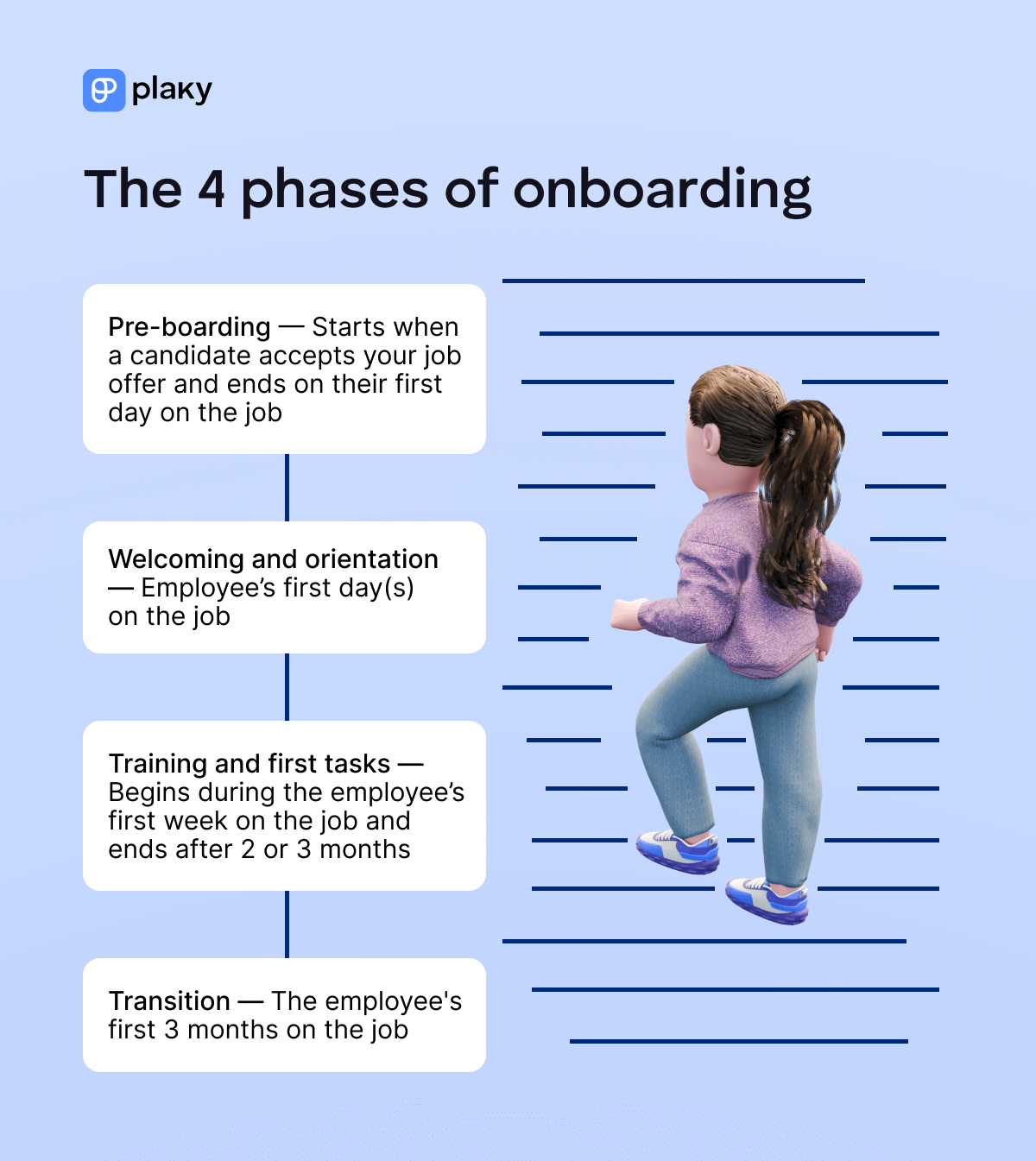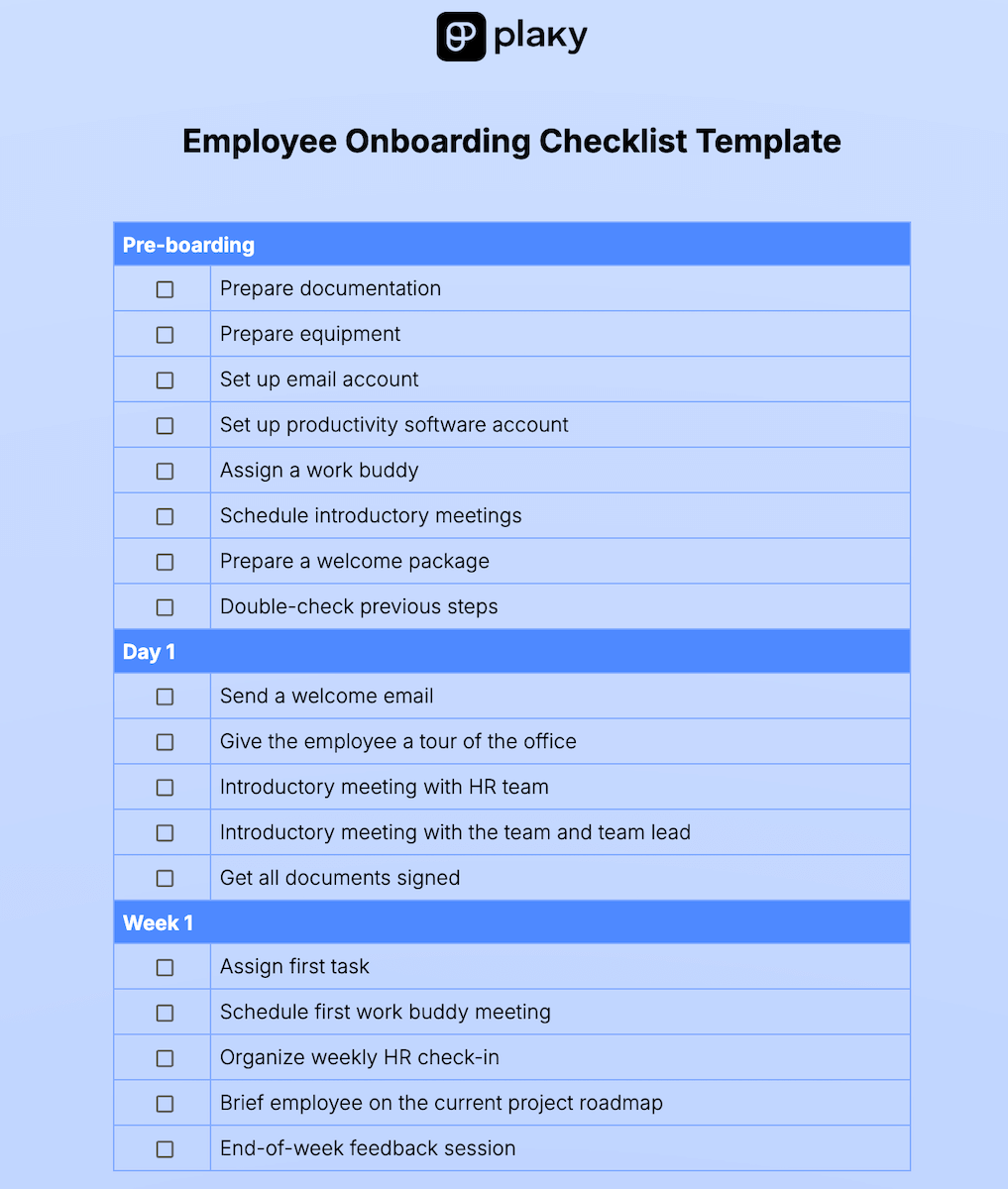Picture this scenario:
A new colleague has joined your company. You gave them a bunch of forms and documents to read and took them on a tour of the premises. Of course, you introduced them to all the coworkers that happened to be in the office at the moment. Onboarding is done, right?
Wrong!
There’s a good and a bad way to onboard a new employee. Since we’ve already given you a glimpse of the bad way, it’s time to counterbalance it with the proper way to onboard someone.
Keep on reading!

In this article:
What is employee onboarding?
Employee onboarding is a process designed to integrate new employees into your company as quickly and efficiently as possible.
This process should enable them to become independent and productive members of the team. So, it includes introducing them to everything from their own responsibilities to your company’s policies and workplace culture.
Benefits of good employee onboarding
If you’ve ever had any doubts about the importance of strong employee onboarding, keep on reading. Here are some reasons good onboarding is crucial:
- Quicker acclimation to a new company culture and increased productivity — A new hire acclimation may take from 3 to 6 months, according to HR professionals. Good onboarding speeds up this process since it boosts time to productivity (TTP) — the time it takes for a new hire to start contributing to the team.
- Increased retention — BambooHR’s Definitive Guide to Onboarding in 2024 states that 65% of employees decide whether they’ll stay at a job during the first month. Good onboarding can tip the scales in favor of them staying, which, in turn, reduces turnover and drives growth.
- Better employee engagement — Employees learn about the company and how their jobs align with the company goals through strong onboarding. This helps them feel engaged almost immediately.
- Deeper understanding of the role and expectations — Thanks to onboarding, new hires understand what is expected of them in their new role, as well as what performance metrics their managers will use to assess them.

New employee onboarding process checklist
Did you know that only 12% of U.S. employees say their company does a good job of onboarding? This certainly means there’s a lot of room for improvement.
So, to make the whole onboarding process a bit easier (and hopefully more successful), we’ve split it into several phases based on the employee’s position in the process.
Each of these phases can involve a variety of minor steps and activities you should consider if you want your onboarding process to be successful.
| Phase | Time period |
|---|---|
| Pre-boarding | 1–5 days before the start date |
| Welcoming and orientation | Day 1–7 |
| Training and first tasks | 1 week to 2 months |
| Transition to the new role | First 3 months |
#1 Pre-boarding phase
This stage starts when a candidate accepts your job offer and ends on their first day on the job.
As the first day of onboarding approaches, it’s good to keep one thing in mind — preparation is half the battle.
Here are some things you can do to prepare for your new employee’s arrival:
- Prepare all the necessary documentation. This can include everything from the work contract and tax forms to NDAs and any other documents required by your country or state.
- Prepare the employee’s equipment. This covers everything the employee will need to do their job.
- Set up the employee’s accounts. This includes their company email and accounts for any software they will be using — productivity tools, HR software, task tracking programs, project management apps, etc.
- Set up a work buddy system. Having a peer to talk to outside their own team and HR can help new employees integrate into the company culture better and meet colleagues who they wouldn’t necessarily have daily contact with.
- Prepare a welcome package. This is a minor but often appreciated gesture that can contribute to making a new employee feel at home.

#2 Welcoming and orientation
As it goes, first impressions are extremely important, and so is a new employee’s official first day on the job. So, this step is all about making sure that the first impression is as good as it can be.
With that said, you should:
- Schedule an introductory meeting with the HR team. For non-remote companies, this can also include a quick tour of the office.
- Schedule an introductory meeting with the team lead. This will get the employee acquainted with their manager and give them an idea of what their first day will look like.
- Sign the required documents. This includes all the documentation that was prepared the week before.
- Let the employee get familiar with their workplace. They should have some time to get accustomed to the tools they will be using and read through any necessary documentation, such as instruction manuals or established procedures.
- Schedule the first meeting with the employee’s work buddy. After this, it should be left up to the employee and their work buddy to set up their future meetings based on their respective schedules.
- Schedule a weekly check-in with the HR team. This allows the employee to voice their opinions and concerns. Depending on the size of the company, these can be 1-on-1 meetings, or they can involve other new hires.
#3 Training and first tasks
An employee’s first week is when they will have the time to get used to their role in the company — and you’ll have the opportunity to see just how well they fit in.
In this phase, you should:
- Bring the employee up to speed with the current project roadmap. They should know what they will be working on in the coming months. Moreover, this helps integrate them into the team because they’ll understand their role in the project.
- Share a document containing thoroughly written processes and procedures with the new employee. This will help them understand the basics of what they will be doing.
- Organize role-specific training for the new hire. You can even assign a mentor to the new employee so that they get acquainted with the matter as quickly as possible.
- Assign the new employee their first task(s). Ideally, this shouldn’t be anything overly taxing, but it should make for a good way to see how the employee performs in their role. For example, at Netflix, new employees get their first projects and tasks as early as day one. Giving them autonomy and responsibility this early shows that the company puts trust in them.
- Organize an end-of-the-week feedback session. Based on their performance during the first week, the team lead can evaluate the new employee’s performance and immediately provide feedback about any crucial weak points or offer praise.

#4 Transition to the new role
The employee’s first 3 months at the company will largely come down to continued monitoring and evaluation. Depending on the organization and the nature of the position, this phase could last as long as 12 months.
At this stage, you should:
- Monitor the employee’s performance based on established key performance indicators (KPIs). This is especially important for employees with less experience, as it will offer insight into how quickly they’re taking to their role and whether they can meet the set targets.
- Have feedback sessions at the end of each month. Much like at the end of the first week, the team lead should use this opportunity to provide feedback to the employee. For example, Bank of America provides 360-degree feedback 6 months after hiring. This helps new employees understand how others view them by collecting feedback from employees’ subordinates, colleagues, and supervisors.
- Continue having weekly check-ins and work buddy meetings. This will ensure the new employee always has someone to turn to with questions, as well as a safe space to provide feedback of their own.
- Get feedback from all employees involved in the onboarding process. This is crucial if you want to get a full picture of the process as a whole and find ways to improve it.

Employee onboarding best practices (with expert tips)
Now that we have gone over the step-by-step breakdown of what an employee onboarding process should look like, here are some specific tips and advice that could help you improve it at your company.
#1 Invest in pre-boarding
Investing in pre-boarding is great for both the company and the new employees:
- On the one hand, helping new hires prepare for their first day helps them overcome new job anxiety.
- On the other, companies offering a pre-boarding experience are likely to keep their recruits for longer as they will be more satisfied with the initial company experience.
According to Tim Toterhi, an HR professional with over 2 decades of experience, pre-boarding is the most important part of the onboarding process:

“A lot can happen between a signed offer and successful onboarding. Top candidates will likely receive counter offers as well as last-minute bids from competing companies. This feeding frenzy could spark anything from a causal rethink to overt buyer’s remorse.”
He further elaborated on what companies can do to avoid losing candidates at this stage:

“To ensure retention post-offer acceptance, be sure to nurture the white space by staying connected in the lead-up to Day 1. A CEO welcome message, an invite to future employee events, and even a simple note from the manager can go a long way toward building the relationship. Connection is everything, especially at the start.”
#2 Establish clear performance expectations
Starting a new job can be stressful for anyone, regardless of position or seniority. To help ease a new employee into their role and avoid any unnecessary worries about missed deadlines, it’s a good idea to clearly establish exactly what is expected of them.
Ideally, you should do this at the end of week 1, during the first feedback session with the team lead.
At this stage, the employee will have had the opportunity to handle some initial tasks, giving the manager some insight into their capabilities. Combined with the pre-existing KPIs, this data would allow the manager to set initial expectations and performance targets for the new employee.
💡 Plaky Pro Tip
To learn more about how to set realistic goals, read this blog post:
#3 Have regular meetings and maintain open communication
Integrating a new employee into the team and the company culture is a major part of onboarding, which is why it’s so important to communicate — especially in the era of remote work.
That’s where weekly check-in meetings and the work buddy system come in.
In short, a weekly check-in with HR serves to:
- Introduce the employee to their coworkers (including those outside their team),
- Provide a safe space for the employee to talk about their experience at the company, and
- Give the HR staff insight into what could potentially be improved in the onboarding process.
Meanwhile, the work buddy system serves to provide a new employee with a peer who acts as a source of information while also promoting informal learning and building trust between employees.
Our contributor Isidora Mirosavljevic, an HR generalist at CAKE.com, also highlighted the importance and benefits of keeping the new employee informed about the onboarding process as they’re going through it:

“Whether you’re a junior or a senior in your line of work, changing jobs always brings something new and unfamiliar. This is precisely why I think you should clearly communicate each step in the onboarding process, in addition to having regular follow-ups. That way, you give the new employee an idea of what to expect, offer a sense of control, and build trust.”
Once you earn their trust, Isidora adds, you can get constructive feedback on your onboarding process from the new employee.
#4 Include managers and team members into the onboarding process
Onboarding is not reserved exclusively for your HR team. Team leaders and teammates should also get involved, as Uku Soot, an organizational growth strategist, advises. He elaborates:

“Incorporating leaders and teammates into the onboarding process will help the new hire feel like a team member from the first day.”
He also suggests regular check-ins within the first weeks. This allows managers to see how the new hires are adapting to the new environment and helps address any potential issues early.
#5 Get feedback from everyone involved in the onboarding process
Isidora Mirosavljevic highlights that you shouldn’t just follow up with the new employee but with everyone involved in the onboarding process — mentors, shadow mentors, work buddies, etc.

“This way, we get feedback through multiple channels and from different angles, which provides important insight regarding future planning and potential improvements that can be made to the onboarding process.”
💡 Plaky Pro Tip
Regular performance reviews can help you understand how a new employee is adjusting and whether they’re making progress. Here are some free performance review templates you can customize to your needs:
#6 Don’t overwhelm new hires with information
As mentioned above, starting a new job can feel overwhelming, and onboarding is supposed to address that feeling, not contribute to it.
Tim Toterhi points this out as a common onboarding mistake:

“Keep it brief. Too many companies waste time overloading employees with information they won’t recall, training they don’t need, and organizational commercials they don’t want. It is one of the least ‘customer focused’ processes that HR provides.”
He further elaborates on how to avoid making this mistake by focusing only on the information that’s relevant to them:

“They don’t need training on systems they won’t use for 6 months or an 80-page slide deck on the company history. They want to know their kids have health insurance, their 401(k) transfers, the hot lunch spots, and well, where the bathrooms are located. You have to hit the basics.”
That said, a crucial part of planning a good onboarding experience is to put yourself in the employee’s shoes and consider what’s the most important information you should be provided at each stage of the onboarding process.
#7 Establish a connection to the company culture
Your new employee stands a better chance of fitting in with your company if they get acquainted with your company culture from the very beginning — i.e., from onboarding.
Uku Soot advises creating an onboarding experience that would fit the company culture:

“Make sure that new employees are well aware of the values, mission, and the way your team functions.”
This will help them connect their own daily tasks to a shared purpose, which will, in turn, make them more engaged from day one.
#8 Make a new hire feel welcome
For Simon Royston, founder and managing director of a successful recruitment agency, the crux of employee onboarding is simple — a new hire should feel welcome in the organization. He highlights that onboarding is a continuous journey that doesn’t end on the employee’s first day.

“What organisations do within that journey will vary, but best practice is remembering what your goal is — to make an employee feel welcomed and socially accepted by an organisation. To achieve that, the onboarding journey should reflect the organisational culture and style — don’t pretend to be something you are not.”
#9 Keep adapting and revising your onboarding process
Nothing is ever set in stone, and there’s no such thing as the perfect onboarding process. So, you should always strive to collect feedback from new employees during the onboarding process and after it’s been completed.
This can be done both through surveys and 1-on-1 meetings with HR personnel.
Surveys allow you to collect general quantitative data and are indispensable in larger organizations.
Meanwhile, 1-on-1 interviews provide you with a more detailed view from the employee and can even contribute to a positive employee experience in itself, as they show the new employee you value their feedback.
#10 Use automation to streamline your onboarding process
There is a way to further optimize your onboarding process and stop wasting time on repetitive tasks — automation.
You can use automation:
- In the pre-boarding stage — Send welcome emails, useful information about the company (company handbooks, dress codes, etc.), and documents for the new hires to sign electronically.
- For training and development — Give your new employees access to online courses, assign them mentors, and track their progress.
- To jumpstart your onboarding process — Use pre-existing templates for the onboarding process.
Uku Soot underlines the main benefit of automation in onboarding:

“It saves the HR time to focus on more tactical relationships like mentoring and coaching. Automation will make the onboarding process to all parties efficient and standardized with adequate use.”
💡 Plaky Pro Tip
If you’re still looking for the right HR management app for your business, take a look at the following article:
FAQ
And lastly, here are some frequently asked questions regarding employee onboarding.
What are the 5 Cs of onboarding?
The 5 Cs of onboarding are:
- Compliance – getting employees acquainted with basic legal and policy-related rules and regulations,
- Clarification – ensuring that employees understand their new jobs and responsibilities,
- Confidence – building up new employees’ confidence in this challenging period,
- Connection – referring to the vital interpersonal relationships new employees should establish, and
- Culture – introducing new hires to the company’s culture, mission, and values.
How long should employee onboarding last?
This depends on the organization and the employee’s role. In general, the process should last no less than 3 months and no longer than 12 months.
What is a standard onboarding process?
A standard onboarding process involves several key elements, but it comes down to integrating a new employee into their role, their team, and the company culture.
💡 Plaky Pro Tip
Wondering what could be the consequences of bad onboarding? Learn about common onboarding mistakes and how they could harm your business:
What is the difference between onboarding and orientation?
Although both onboarding and orientation serve to support new hires and help them acclimate to the new job, there are differences between them.
Orientation is a quick introduction to the most important information concerning the new company. It’s the same for every new hire, regardless of their job position.
Onboarding, on the other hand, offers continuous support to new employees and is more role-specific than orientation.
What types of onboarding meetings are there?
Here’s a list of onboarding meetings you can include in your new employee’s onboarding process:
- Orientation meeting — serves to provide the guidelines for the first week. New hires get all the general information on the job and the company.
- Team introduction meeting — a casual meeting with the team, like an informal lunch or a coffee break, for the new hire to get to know their teammates in a more informal setting. This may help build connections and create a sense of belonging — the new employee will instantly feel welcome.
- Department meeting — gives context about the company’s organization and its future plans and goals.
- Product meeting — for detailed insights about products/services offered by the company.
- Training meeting — a role-specific training that prepares the new hire for their individual job.
💡 Plaky Pro Tip
To learn more about the importance of communication in managing projects, read this blog post:
Say hello to an automated employee onboarding process
Although onboarding is a flexible process, it does include many systematic tasks, such as:
- Keeping track of training dates,
- Scheduling meetings, and
- Managing multiple employees’ onboarding processes.
So, HR professionals should use technology to organize all the information, automate repetitive tasks, and facilitate the whole process.
This is where a project management app (PM app) might come in handy.
Using a simple and intuitive PM tool like Plaky, you can easily track the progress of not only one, but several onboarding processes at the same time.
What’s more, Plaky offers a pre-made employee onboarding template that helps you automate repetitive tasks and save precious time.
Get our employee onboarding template
Gone are the days when you had to manually create a new to-do list for every new employee. Now, you can easily organize the new employee onboarding process with our template by:
- Keeping track of all the newcomers — Start from the pre-boarding phase and make sure you know what stage your new employee is at any given moment.
- Sharing important files and documents — Keep all the relevant data (such as resumes or cover letters) in one centralized place so that you don’t waste time searching for them.
- Communicating with your team members — Use comments or @mentions within each task to facilitate collaboration and avoid the chaos of app switching.
- Delegating tasks — Simply assign tasks to a teammate of your choice so that they never have to wonder what their next task is.

Alternatively, if you want to make sure you’ve covered everything in all the onboarding phases, you can use a checklist such as this one:

Get our employee onboarding checklist template
Bonus: Plaky also offers a recruitment template, which makes your talent acquisition and recruitment process easier, too — so you can say goodbye to donkey work there as well!
Speaking of never again dealing with repetitive tasks, Plaky has recently introduced board automations (in the Pro and Enterprise plan). You can use automations with items, subitems, or even a combination of both, to:
- Update item fields,
- Move items, or
- Manage who’s subscribed to a card.
All you need to do is customize the basic formula When something happens (Trigger) → Then do something automatically (Action). The rest is done by Plaky. You’re free to concentrate on more creative parts of onboarding — such as check-ins with your new hires or coaching, for instance.
The best part? You don’t have to worry about making mistakes, as automations, unlike humans, aren’t prone to errors.

Don’t let the onboarding process wear you down. Start your 14-day Plaky trial today!

